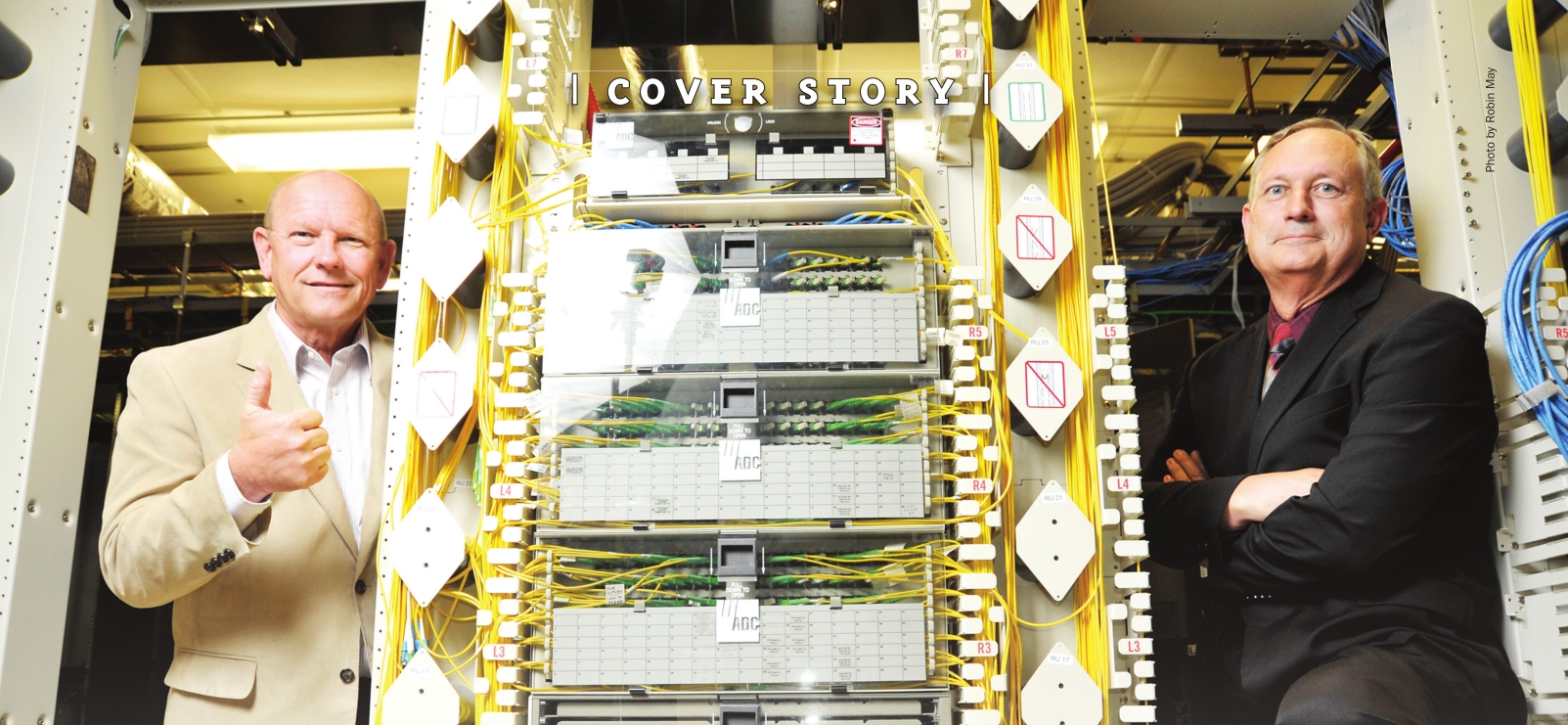
More than a decade ago, Joey Durel and Terry Huval set off on a risky trek — bringing fiber tele-com to Lafayette.
The city embraced the journey and has been on a promising trajectory since.
More
than 100 years ago, conventional wisdom was that building a utility
system in a one-horse town like Lafayette wasn’t a good idea. The big
corporations that provided electricity decided that it wouldn’t pay them
enough to bring light to the city, and so they told Lafayette’s people
they would just have to wait. They were in charge, they had the money
and they wanted Lafayette to be a good little city and grow on their
schedule, not hers.
But
the people who built Lafayette weren’t really into waiting, or
conventional wisdom, or doing what they’re told, and so they made what
was predicted to be a huge mistake: They sold bonds and built their own
damn utility system. Now the descendants of those people have the
largest municipally owned utility system in the state, and they enjoy
the most reliable electricity at the best price in Louisiana. That
system also regularly dumps cash into the city’s coffers, which is in
turn used to support infrastructure and government functions.
LUS
is one of Lafayette’s most prized and beneficial assets, all because
the people of this city suffer from a unique kind of audacity, the kind
of audacity that has marked the development of many of Lafayette’s most
successful efforts — an upstart international music festival, an ice
hockey team in a steamy Louisiana town and a government-owned fiber
telecommunications network.
This
month marks the 10th anniversary of the public vote that authorized the
sale of bonds to build LUS Fiber. It’s only been six years — mostly
because of delay tactics by more of those big corporations — since the
system started offering service to residents (and five since it was
offered to businesses),
but
already LUS Fiber is going to operate in the black this year — even if
you include the inflated depreciation percentages applied to telecom
systems. If you look only at operating costs, bond payments and
revenues, the fiber system has been cash positive since 2012.
LUS
Fiber brings the “fastest Internet in the world” to Lafayette, with
residential gig service equaled only in Tokyo, Seoul, Singapore,
Chattanooga and Kansas City. Our fiber system has attracted high tech
industry to Lafayette, creating more than a thousand jobs (so far). The
mere existence of this system has forced other utility providers in our
area to upgrade their systems ahead of their schedule and keep their
prices low — not to mention making Cox a better company for locals to
deal with. LUS Fiber revenues are projected to reach $50 million
annually in the next nine years.
By
any measure, it is a success — just six years in, a success. And those
who said (disingenuously, at best) that it would fail were wrong. Wrong.
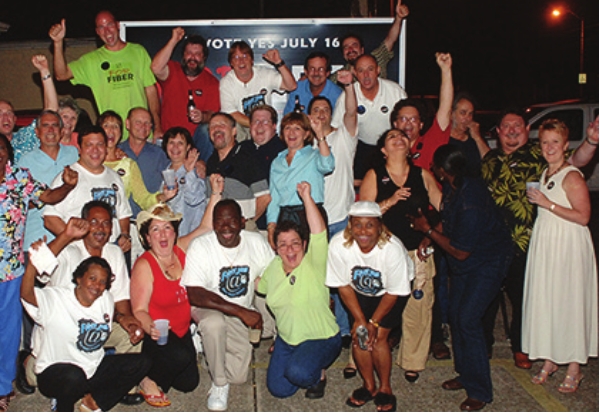
There's
a reason that, even today, Lafayette is one of only a handful of
American cities with a municipally owned fiber system. Even here, in a
city with 100 years of utility experience and that pesky audacity, a
very specific set of circumstances had to exist, and a very specific set
of people had to get involved, for it to happen.
City-Parish
President Joey Durel describes it as planets aligning. There were so
many spokes to the wheel, and if just one had not been in place, he’s
not sure we’d be marking the anniversary of anything this month.
“I guess the good news was, I didn’t know what I couldn’t do at the time,” Durel says.
Among
those planets were Durel and Terry Huval, LUS’s longtime director and a
highly respected person in the utility world. Also required were a
supportive City-Parish Council made up of men with a bent toward
progressive thinking, something that was lacking before they arrived.
And the last piece was a group of community activists and creative
types who were, perhaps, the most audacious of all.
For
Durel, a Republican business owner who ran for public office with the
(laughable?) goal of making Lafayette a better place, the story really
begins in November 2003, right after he was elected city-parish
president for the first time. He’d worked with a transition team to
decide which department directors would stay, and he was making the
rounds to break the news.
Huval was definitely a keeper. During that first meeting, Huval said, “I want to show you something.”
He pulled out a binder of information he had picked up over the years, about the idea of fiber to the home.
Durel,
coming from a small business, Chamber of Commerce background, had a
predictable reaction: “Why would we compete with the private sector?”
Huval had the answer, and by the time Durel left Huval that day, he was
saying something else.
“I
said, ‘Shame on us if we don’t continue to look at this. Shame on us if
we don’t try until we get to a brick wall we can’t pass,’” Durel
recalls.
Two entities
tried their best to be that brick wall: Cox Communications and Bell-
South, later AT&T, telecommunications companies that a) didn’t want
competition in Lafayette and b) didn’t want this cancer of municipally
owned utilities getting out of hand. Durel’s wife Lynne “is much smarter
politically than I am” and asked him flat-out why on earth he wanted to
fight billion-dollar corporations to do this.
The
answer was simple. “I was tired of watching politicians allow
out-migration from our state. I had heard a lot of talk, but nobody ever
did anything about it,” Durel says. He wanted to find that one thing
that could change Lafayette for the better: “I thought this was our
opportunity.”
He had to look at the risk to the city’s existing assets first.
“With
fiber, I felt early on that this was really low-risk,” Durel continues.
“Despite the rhetoric of the opponents and the dollar amount, I felt
that if we spent all the money and we couldn’t get any customers, the
cost to the citizens would be minimal, but the possible payback was so
good. The political risk, honestly, I never cared about it.”
In fact, two people Durel really respects came to his office to tell him that maybe fiber should be a “second-term issue.”
“I
told them, thanks for caring about me, but I swore I’d never have this
conversation, about something that’s the right thing to do but I won’t
do it because it’s political suicide,” Durel recalls. “I told them that
if I got thrown out of office for trying to do the right thing, I’m OK
with that. I have a great wife and a great life, and I’m OK with going
back to that.”
He also believed that politicians who work like they will only have one term are the ones who get rewarded with a second one.
“If you do the right thing for the right reasons, people will respect you,” Durel says.
And they did, and returned him to office twice.
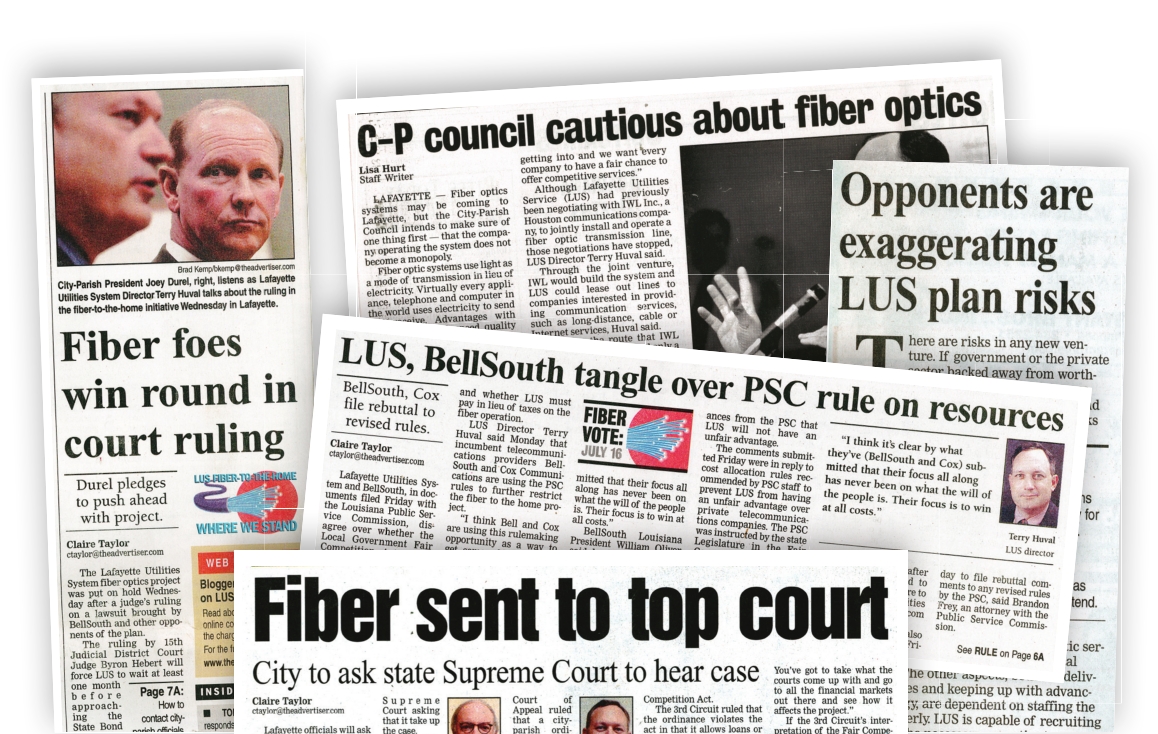
Terry
Huval is one of those audacious Cajuns, a man who has voice mail
greetings in French (first) and English (last), and who is known for his
devotion to classic swing, Cajun music and his red beret. He’s the
reason callers to the LUS automated system hear folklorist Amanda
LaFleur’s perky “Bonjour!” instead of some canned, impersonal cut-rate
Siri.
Huval’s fiber story starts a long time ago.
“A
few years after I came to LUS in 1994, we decided to highlight our
100th year since the 1896 vote to establish the electric and water
system. I was always intrigued as to what led the citizens in Lafayette
to vote for that initiative, and later learned that it was simply a
strong desire of the citizens to move their community forward,” he
remembers.
Communities
have always needed “highways of commerce” to grow, Huval says, be it
waterways, railroads, electricity or interstate highways. For him, it
was clear that broadband was the highway of the future.
“The
vision was simple: Lafayette was already benefiting from a very
successful electric, water and wastewater system, and LUS could leverage
its expertise to offer Internet and other telecommunications services,
if that is what our community wanted,” he says. “After we threw out the
idea, the entrepreneurial, wildcatter spirit of Lafayette seemed to take
it from there.”
That
spirit had some help in the form of critical political mistakes by the
incumbent providers. Durel remembers that the president of BellSouth
came to a Rotary Club meeting here and basically said that Lafayette was
getting above itself, adding that “New Orleans doesn’t even have this.”
“That
was the wrong thing to say to this community,” Durel says. “If we can
be first, that is something this community will wear with a sense of
pride. It’s that risk-taking mentality, coupled with the culture of
working hard and playing hard, all working together.”
But
even with all that spirit, one thing this community did not have was a
long, strong history of coalition-building, of activism. That’s where
that audacious group of citizens came in, to build an army that would
fight for an amazing idea.
“It’s
a pretty big deal, what we accomplished,” says community activist John
St. Julien. “Community organizing is something that Lafayette has been
deficient in. The Horse Farm fed directly off the fiber fight. Other
than those two issues, there’s not been much in the way of civic
activism here.”
But
that is what happened. St. Julien and his wife, Layne, Stephen Handwerk,
Mike Stagg, André Comeaux, Gobb Williams, Don Bertrand, Bill
Fenstermaker, Kaliste Saloom III and dozens more banded together in a
motley crew of old, young, establishment, non-establishment, black,
white, Democrat, Republican, you name it. That citizen group created and
ran the campaign for that July 2005 election.
There’s
a picture of that group on election night, standing in the street,
holding signs, fists raised; it’s a perfect capture of that spirit, says
Gobb Williams.
“We
were waiting for the results ... I think we were at the Cajundome;
wherever we were, as a group we started looking at each other. We all
had the same thing in our hearts, that we did not belong there. And we
passed the word around, let’s get out of here,” recalls Williams. “I
said we can go to my office, and so we came to the parking lot at my
office and celebrated the victory. Republicans, Democrats, independents,
black, white, Spanish, French, all working together for one cause. I
always get chills when I look at the picture, because I realize that we
had this group of people, a core of people, working for one cause,
uniting our resources, and we were victorious.”
Handwerk,
now director of the state Democratic Party, had recently moved to
Lafayette to run a web development business. He had a Cox modem for
downloading but had to use dial-up to send anything.
AT&T had terrible service, he says. Then he heard about fiber, and met with Huval.
“It
all made so much sense. But with the conservative leadership of this
community, I felt there was no way the Republicans would sign on,”
Handwerk says. “Then I heard the LUS story.”
A community that had taken that kind of step in the 19th century might actually accomplish this, he thought.
But
it wasn’t easy. “It seemed like one obstacle after the next,” Handwerk
recalls. “We were a bunch of community activists, and there were these
huge companies against us. It really was a David vs. Goliath situation.”
That was exactly the reason Gobb Williams got involved.
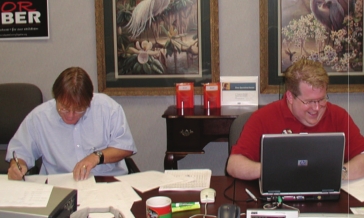
“No.
1, what really sold me on it, was that these people in our government
were willing to stand up against corporate America to provide us with an
alternative,” Williams says. “And, I had never seen such a diverse
group of people ready to fight for and believe in the same things I
believed in.”
One of the biggest problems, everyone agrees, was explaining to people just what the heck fiber meant.
“Cox
and AT&T were spending a huge amount of money to distort the
conversation, and what was worse, the biggest obstacle — nobody knew
what we were talking about. We would send out a mailer saying ‘Vote for
Fiber,’ and they thought we were talking about bran flakes,” Handwerk
says.
“We wondered how
much this idea had resonance with a whole lot of people whose hobbies,
jobs, interests didn’t run that way [to technology],” recalls Layne St.
Julien.
But the larger idea did. She remembers in particular a “wonderful” man who lived on Eighth Street.
“He
called to ask for a yard sign, and I went over there. He must have been
75, 80 years old, and lived in a very old house,” she says. “I asked
him why he felt so strongly about this issue. And for him, it was kind
of a patriotic thing. He felt like it was a good thing for the future
and for kids. He pointed to the children playing up the street and said,
“All of these kids can use that.”
“For certain of us,” she says, “that was a defining moment.”
The group tailored its message to each market. Knocked on doors — so many doors.
“We
wrote phone scripts. We worked the phone bank,” Handwerk recalls, with
Republicans and Democrats working side by side. “It was really surreal,”
he says, “but it was empowering as well.”
That’s one of the planets aligning that Durel mentions.
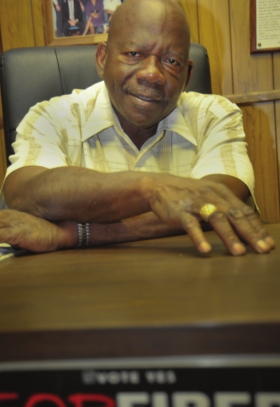 “I’m
proud of the parish executive committees of those two parties holding
their noses but speaking in unison,” Durel says. “They really did unite
the people.”
“I’m
proud of the parish executive committees of those two parties holding
their noses but speaking in unison,” Durel says. “They really did unite
the people.”
Williams says that unity is still “a memory I cherish.”
“I
will remember that as long as I live, and I say this with a full heart,
the people I worked with on that campaign, they will forever have a
special place in my heart,” Williams says. “Erin [May] made a little
card during the campaign, a small card with everyone’s name and phone
number on it. I still carry that card today in my wallet. I will never
get rid of this card.”
Aside
from the truly grass roots nature of the citizens’ campaign, two other
items played a big role in the success of it. First, the city
administration started using another Lafayette anomaly, another one of
those upstart, ridiculous, unique Lafayette assets — Acadiana Open
Channel. The weekly
program hosted by city officials offered plain-spoken information, and again — unbelievably — it worked.
“That
helped us evolve to the next level, going to a vote, mobilizing
people,” Handwerk recalls. Secondly, the “big boys,” Cox Communications
and AT&T [nee BellSouth] started dumping money into a campaign that
can only be described as ham-fisted.
“They
did ads with people who purported to be from Lafayette, but they had
fake Louisiana accents. Just terrible accents, and white trucks with
Texas plates,” John St. Julien recalls. “They did all of this stuff that
was so dumb.”
For
instance, there was the push poll, John St. Julien remembers. “It was
about 45 minutes long, and full of the most outrageous questions.” One
started with information about the LUS lawn-watering schedule, which the
pollster referred to as “rationing.” Then the pollster asked how you
would feel if your Internet was rationed so your neighbor could download
pornography.
The
fiber group would pull out each lie or distortion, break down all the
false information and send it out in email blasts to show just how
ruthless the big boys were going to be. And it turned out to be
invaluable to the pro-fiber side. “There’s no better way to educate the
community than controversy,” Durel says. “I hate taking the brunt of it,
but I learned through this process, if you want something done and the
public needs educating about it, you have to have controversy.”
There was a lot of money spent, and not just to stop Lafayette. It was to make an example out of Lafayette.
“They didn’t want any other uppity cities going down this road,” Handwerk says.
“This was a finger in the dike.”
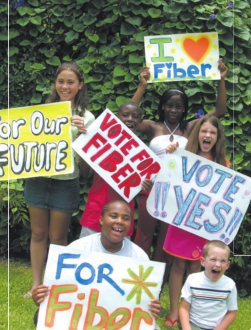 The citizen group was able to settle into reaction
mode: Once the dumb, clunky messages came out, they took to their
emails and blog and pointed out every single lie. It wasn’t just an
opportunity to educate; it was an opportunity to draw on local pride
and, again, that spirit of audacity. “It was a lot of fun to watch,
waiting for them to say something else ridiculous and outrageous,” John
St. Julien remembers.
The citizen group was able to settle into reaction
mode: Once the dumb, clunky messages came out, they took to their
emails and blog and pointed out every single lie. It wasn’t just an
opportunity to educate; it was an opportunity to draw on local pride
and, again, that spirit of audacity. “It was a lot of fun to watch,
waiting for them to say something else ridiculous and outrageous,” John
St. Julien remembers.
One critical aspect, he adds, was the participation of Durel and Huval.
“To
have public officials willing to advocate out front, to be — in this
day and age — so forthrightly un-corporate, I was just blown away,” John
St. Julien says. “They were willing to say, ‘These are greedy
outof-town corporations.’” The “big boys” really would do just about
anything, as is evidenced by a story Huval tells. He was on Gov.
Kathleen Blanco’s broadband advisory council, and was at the State
Capitol for a meeting one day. “A Cox representative asked me to have
coffee in the cafeteria there. And this person told me that Cox was
creating a new director of operations position, and that he/she had been
asked to approach me to see if I was interested,” Huval recalls.
Cox offered that job to at least three others in Durel’s inner circle, Durel adds.
And some detractors haven’t stopped.
Tim
Supple has been a vocal opponent of the plan since its inception and
continues to be critical of the fiber system to this day
— even though he’s a fiber customer and calls it “a wonderful product.”
Supple
feels that most customers don’t need Internet at the speed and capacity
fiber offers, and that the plan was to make a lot of profit in
telephone and cable TV, markets he says are “drying up.” He insists on
comparing current financial statements to the feasibility study done in
2004 to determine if LUS Fiber could work.
“Everybody
can have an opinion, but nobody can have an opinion on the facts, and
the facts show losses of $50 million they have to make up,” Supple says.
The problem with Supple’s facts is they don’t match the figures.
The
feasibility study predicted that, by the fifth year of offering
services to both residential and business customers, telephone sales
would top $9 million, TV sales would be at $12.5 million, Internet sales
would be less than $5 million, and wholesale sales would be
approximately $2.7 million. That’s a total of $30.1 million.
But
the figures were, for the fifth year of sales: $4.8 for telephone,
$11.5 for television, $11.3 for Internet and $3.1 for wholesale. That’s a
total of $30.7 million. So while there was an over-estimation of
telephone sales, there was an under-estimation of wholesale sales and a
very large under-estimation (more than 50 percent) of Internet sales. In
the end, it’s a wash because the projected revenues are almost spot-on —
something one would not really expect to happen, since the feasibility
study did not take into account the delays and costs associated with the lawsuits filed by the “big boys.”
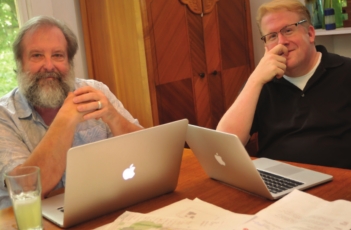 Also,
the “losses” referred to by Supple aren’t valid, either, Huval says.
Supple is trying to combine long-term debt and depreciation with annual
net income, and the two don’t mix, according to Huval. The required
depreciation is close to $54 million currently, but the “continuous
review” that Huval’s people have done projects only $5 million in needed
upgrades in the next 10 years. Fiber assets are on a depreciation
schedule of 30-40 years, but are like power lines in that they are more
likely to last 50-60 years.
Also,
the “losses” referred to by Supple aren’t valid, either, Huval says.
Supple is trying to combine long-term debt and depreciation with annual
net income, and the two don’t mix, according to Huval. The required
depreciation is close to $54 million currently, but the “continuous
review” that Huval’s people have done projects only $5 million in needed
upgrades in the next 10 years. Fiber assets are on a depreciation
schedule of 30-40 years, but are like power lines in that they are more
likely to last 50-60 years.
“Businesses
that survive make needed adjustments tied to real market considerations
— not based on a study that was based on some arbitrary requirement in a
state law,” Huval notes.
As far as the big boys go, a spokesperson for AT&T could not be reached for comment.
Cox
declined comment on the job offers to Huval and others and elected not
to address specific questions about the role it played in fighting LUS
Fiber.
Back to
the campaign for fiber, that alliance between the city administration
and the citizens’ group wasn’t all roses and rainbows. The citizen group
was promised assistance with funding that never came. The results of
the market
survey
done early on were never shared with its members, even though it could
have helped with their phone bank and door-knock planning.
And, for John St. Julien, LUS Fiber hasn’t reached its full potential.
“Did I expect it to look like this? Yes. Is
it what I most want? No,” he says of the current system. “But Terry was
nothing but forthright. He wanted a utility; reliable, low-cost
service. He was never all that interested in issues that I was
interested in, like the digital divide. ... What I really expected was a
conventional telecommunications offering, just as the electricity
company was conventional. There is no political under-the-table
involvement. There’s no favoritism. I’m fully cognizant of that, and I
like that, I’m good with that. But....”
John
St. Julien has wished for more aggressive and creative marketing, for
more progressive implementation — citywide WiFi for instance — but he
hasn’t seen that. (See related sidebar for an update on citywide WiFi.)
Handwerk
has wishes on the more technical side, in terms of LUS Fiber working
with co-ops like CLECO and SLEMCO to expand the system. But he feels
that even people who don’t have LUS Fiber are benefiting from the
system. “The other companies were forced to upgrade,” he says. “That
rising tide launched all these ships. You’re paying less today than you
would have, and you get better service.”
“From
the beginning, we listened to lots of ideas. Some of them, like the
peer-topeer Intranet idea, were ones we embraced and deployed. Some
ideas felt too radical and unpredictable for us to feel comfortable
with,” Huval says. “While ideas and visions were welcome, we knew that
our most important immediate task was to make this system a financial
success. We had to strike the right balance between technology and
financial viability.”
In
terms of profit, the delays created by the state statute and the
lawsuits aimed at shutting the project down hurt the most, he says.
“We entered this arena as underdogs.
We
had to fight for every success we achieved. We were forced to accept a
law that was going to make our entry into this business far more
difficult. We incurred lawsuit delay after lawsuit delay — delays that
impacted our entry into this competitive market for three years. I know
of no local government telecom system that has had to go through the
extreme challenges we encountered,” he notes. “If we would not have had
all these early legal impediments, we would have been on-line faster and
drawn in far more customers, more quickly. If we could have captured
the level of strong enthusiasm in those early years, there is no doubt
our revenues would have been stronger, and we could have been even more
creative and aggressive. ... Under the circumstances, there was not much
we could have done differently and still reach a successful business
result.”
So the battle
is ongoing, but right now, Durel says, “cash flow is positive.
Technically you can say it is still showing a loss. At the end of this
year you won’t be able to say that.”
Some
will still want to say it, and will say it — but to do so would be
disingenuous at best, he says. “I will never understand how anybody, a
councilman or a consumer, would think that hurting our system benefits
our people.”
Even
though the fiber system is, itself, an asset on so many levels, and has
forced better service and lower prices for our citizens — and that alone
is a benefit — Huval says profit is still critical.
“I think the citizens would want to see the system profitable,” he says. “They’ve made an investment in this system.”
Looking
back, Durel feels that fiber did turn out to be that defining
accomplishment, the one (along with the Horse Farm) of which he’s most
proud.
And let’s be
frank: Who knew at the time that Durel had it in him, that so early in
his political career he would risk so much on such a bold initiative?
No one. Except for Durel himself — and Terry Huval, of course.
“I
knew this had the possibility of transforming Lafayette — that 25 years
later, Lafayette would be a better place because of this,” Durel says.
“Even if fiber just breaks even, but we create thousands of new jobs
because of it, that’s a win.”